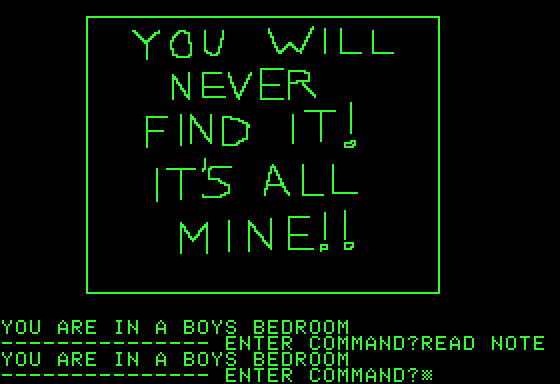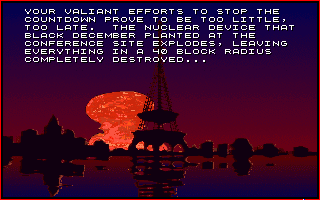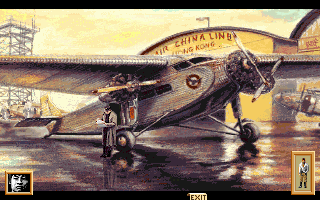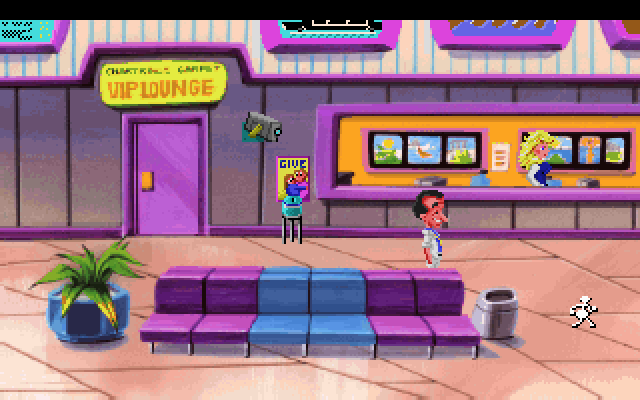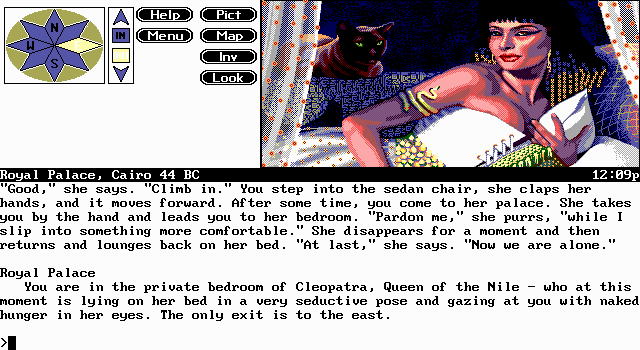Written by Ilmari
There is an immense number of adventure games and the official playing list of TAG contains only a small selection of them. The games that make it to the official list have passed a tight criteria that we hope will let through only the most memorable adventure games. Then again, someone might think that the rules have been too strict and some forgotten classic has slipped through our hands. Well, since TAG is now a community effort, there is a perfect chance to rectify this - one can just write a review of this hidden gem, and we might publish it as part of our irregularly appearing Missed Classics -series. The rules of the official playing list can be followed, but reviews of a more relaxed formula fit also right within Missed Classics. We’ve already seen Joe’s take on Sierra’s
Mystery House and now I will move to an even more distant past.
Personally I was always a bit disappointed that Trickster limited TAG to graphical adventure games, since so many memorable text adventures had to be ignored (then again, if that decision would not have been made, we would probably still be stuck in the 80s). It is still debatable whether at least purely text-based adventure games should not be included in the Missed Classics, and I would love to hear opinions on this in the comments. Nevetheless, I think the rules can be bent once, when we are dealing with the game from which the whole genre got its name: Adventure, also known as Colossal Cave.
The story behind Adventure has been told over and over again by far more talented and well-informed writers, so I’ll just give a quick summary. I urge any reader who is interested of more details to check Jimmy Maher’s
Digital Antiquarian or Rick Adams’
Adventure page.It all began with Will Crowther, one of the programmers behind ARPANET, the predecessor of Internet. In addition to programming, Crowther was known as an enthusiastic spelunker and was especially famous for exploring part of the Mammoth-Flint Ridge Cave System in Kentucky with his wife, Patricia Crowther. Due to their divorce in 1975, Crowther was separated from his daughters and was then inspired to write a program that they might find amusing.
![]() |
| The man behind it all, Will Crowther |
The program recreated geography of a part of the so-called Bed Quilt Cave of the Mammoth Cave System. For a long time, it was thought that Crowther’s original program was nothing more than that - a mere guided tour through a cave system. When the original code of Crowther was discovered in 2005, it became clear that this first stage of Adventure was something more. It had obvious D&D influences, like magic words and little dwarves running around, but most importantly, it already had puzzles and was thus a primitive adventure game. Yet, it was also clearly unfinished and had no proper ending.
However incomplete, Crowther’s program was spread from one person to another and eventually found it’s way to Stanford Medical Center’s computer system, where it was discovered in 1977 by Don Woods, a graduate student in computer science at Stanford University. Woods decided to contact the author of the program and ask a permission to complete it. This was quite a feat in itself, since the program had no more suggestion of its origin than the surname of Crowther. Fortunately, the Internet of late 1970s was far smaller than nowadays and Woods could simply send e-mail to all Crowthers in the net. Crowther gave his permission and Woods began adding features and especially ending to the game that was now known as Adventure. This is the definitive version of the game that gave its name to the genre we so love.
![]() |
| Don Woods receiving award for his work on Adventure |
Rest is then history. Adventure has been ported to many computer systems and many enhanced versions of the game have also appeared. I am playing Don Ekman’s DOS port of the game, which should be as close to the original mainframe Adventure as possible. It even faithfully recreates the possibility to set “opening hours” for the game - a feature useful in mainframe versions, because people were not encouraged to use all their precious time with playing Adventure. Since I’ve played the game earlier to a successful completion and this will not be part of the official playing list, the following will be more like a guided tour through the prominent features of the game.
Spelunker’s diary: Who would have guessed that a cave in the middle of Kentucky would contain volcanos and even dragons! Somehow I feel that I’ve fallen into an elaborate game of treasure hunt, so unbelievable everything seems. And what did that voice say about the cave closing?
![]() |
| I hope the screenshots satisfy even the readers with a more refined taste |
Adventure wastes no time for beginning. If the player wants some info when starting, the game mentions a legendary Colossal Cave, where magic is rumored to work and which should contain immense riches, if one just is able to get back alive. Without any further explanation player is then dropped in a forest near a small brick building. The building itself contains some basic equipment for caving expedition – lamp, food, water and a set of keys – but the legendary cave is not in the immediate vicinity. The forest itself contains few rooms and there's also a valley and a hill, but these are all mere scenery. Instead, one should follow the stream, which soon ends with a locked grate, behind which the entrance to Colossal Cave lies. The keys found in the building fit, and the player finally steps into the cave itself.
While the description of overland rooms is nothing out of the ordinary, in the cave system Crowther's expertise on the topic becomes evident – I have no idea what a frozen river of orange stone looks like, but it sure sounds like coming from a person knowing his geology. Some rooms, evidently added by Woods, have more fanciful features. For instance, in two rooms you see a shadowy figure waving to you through a window - later you’ll learn that these rooms overlook a huge canyon containing an enormous two-sided mirror.
![]() |
This is what frozen river of orange stone looks like.
Anyone interested of the real Colossal Cave should check
the photos available in an article by Dennis G. Jertz.
It sure looks more cramped than I thought it would be. |
Now, while in graphical adventure games it is fairly easy to see how the rooms connect to one another, especially the earlier text adventures made navigation truly difficult. One might move north, but going back to south might land you to a completely different place than the one you originally started. In Adventure this makes some sense, since you are meant to walk in an elaborate cave system - you are choosing a tunnel leading out from the northern side of a room and this tunnel might lead to east side of another room.
![]() |
For those who want to orient themselves better,
here's a map of Adventure by courtesy of Joe Pranevich.
(Here's a better version)
10 CAPs for the first one to point out something missing from Joe's map |
The navigation becomes truly difficult, when the descriptions of the rooms become completely identical - this happens in the famous “maze of twisty little passages, all alike”, where all rooms are described with just these words. Joe has detailed rather well how to handle such mazes in his Mystery House review, so I’ll not bother explaining it again - I’d just like to point out that I personally find them a bit tedious, adding nothing but wasted time for the game play. While this maze originated with Crowther, Woods added a second maze to the game, this time one of “twisting passages, all different”. In Woods maze the descriptions of the rooms are slightly different, with same words, but in different order, which makes mapping it much simpler.
Another obstacle in mapping Adventure - and one that fortunately felt quickly out of fashion - is the randomness in movement. Both in the overland forest section and in the caves themselves there are some rooms in which moving to certain direction won’t have a certain result, but the player will land to a random destination. This is probably meant to suggest how utterly confusing movement in the area is, but I find it rather perplexing that even after hundreds and hundreds times of going through the same rooms the would-be spelunker hasn’t learned to navigate through the tunnels.
Especially irritating this randomness of movement is in case of the famous puzzle of the last lousy point. Gaining the point is rather easy. You’ll find a magazine in the caves, addressed to certain Witt. Then you’ll just have to find a room called Witt’s End and drop the magazine there - the point is yours. Problem is then finding your way out of the Witt’s End, when going to any direction seemingly lands you back to the same place. Solution is to move to any other direction except west - you have a small chance to land somewhere else than Witt’s End.
Speaking of points, the game does have a scoring system, added by Woods. You gain points by finding the cave, but most of the score comes from discovering treasures and moving them to the safety of the brick building (especially the latter part is not explained well in the game and the player might well wonder what to do with all this gold and jewelry). Points can also be lost - the game offers hints, but charges points of it. Furthermore, after player dies he can choose to be resurrected, which also costs some points, but lets you keep all the treasure you’ve managed to accumulate. In the original Adventure (and also in the port I am playing) the maximum score was 350.
![]() |
| Yes, I am back alive again! |
![]() |
| But because I used up my lamp, I am still kicked out of the game. Doh! |
Now, picking the treasures up is usually the easy part and the challenge lies in getting forward to the places where treasures lie. Most of the cave system is without light and wondering around in dark leads eventually to falling down a pit, so after entering the cave, first problem is quickly to get some light. This might not be as easy as it sounds. True, the brick building contains a lamp, but since the game’s parser accepts only two words in a sentence, it is a bit tricky to find the right formula for turning the lamp on - it happens to be just “lamp on”. The lamp works with batteries, which have a tendency to run out. The player can find a battery dispenser in the “all different” -maze, but buying a battery requires some coins, which as a treasure are then deducted from your score. A player wanting to get a full score must then be so fast that new batteries are never required.
The first real puzzle the player will face concerns the rod, the parrot and the snake (sounds like a great rock band). The first items you’ll meet inside the Colossal Cave are a cage and a rod that has the appearance of being magical (later on you will have to wave the rod to create a crystal bridge over a chasm - somewhat unfair puzzle because there is nothing to hint that waving will have any effect there). Next you’ll meet up a bird, which will probably seem frightened and fly away, when you try to pick it up. After a few steps down the cave and you’ll get into an ominously named hall of the mountain king, where a snake guards the entrances to further rooms.
The solution to this conundrum requires careful inventory management. The player must have the cage so that the bird can be carried - this is very obvious. What is not so obvious is that the bird is afraid of the rod. So, before the bird is picked up, the rod must be dropped. What use is the bird then? You shouldn’t feed it to the snake, which would still be guarding the passageway. Instead, you are meant to throw the bird, which then scares the snake away.
I am not going to go through all the puzzles of Adventure in detail. Most of them seem rather commonplace - at least until you consider that these puzzles were bright new, when the game came out. Oiling rusty doors and feeding hungry bears is something we’ve seen in dozens adventure games after this.
![]() |
| Watering a plant and climbing it: 5 CAPs for a similar puzzle in another adventure game |
Compared to later Infocom games the two-word parser makes the puzzles somewhat easier. With Infocom games the player would be expected to write down exactly where the bird is to put, but in Adventure holding a cage and picking up the bird is enough. Similarly, the player is not meant to tell, which tool he should use for opening an oyster, it suffices that he is just carrying the right item. An interesting twist on this theme is the use of a pillow - you will find a delicate vase, dropping of which leads to its shattering, unless the room contains a pillow, on which the vase is then dropped.
Note how important is the ability to drop things - something rarely found in graphical adventures. Adventure comes with an inventory limit, which forces the player to drop items occasionally. Furthermore, there is a place where the inventory items prevent movement forward - the passage supposedly becomes so tight that you cannot get through. Then it’s just a matter of leaving your items behind, while you attempt to move through the toughest spot. In another room you’ll find a particular treasure (gold nugget) that is apparently so heavy that you cannot carry it up and you’ll have to find an alternative route to take it outside.
Another interesting feature of Adventure are the magic words. At the same spot you find the magic rod you’ll also see the word “XYZZY” written on a wall. Using that word in that particular room lands the player back to the brick building and doing the same thing at the building transfers one back to the XYZZY room. I remember being confused about all of this, when I first played the game - I thought I had to have the rod in possession and that saying XYZZY would somehow invoke its magical powers. Indeed, I think that the magic words should have been introduced more substantially than just by telling that magic works in the cave and by placing an incomprehensible scribble on one room (especially as some rooms have scribbles that do not work as magic words). Of course, the matter would be different if all the magic words were nothing but shortcuts, like XYZZY and PLUGH, which one hears a hollow voice saying somewhat further down the cave, but two of the words are also essential for solving actual puzzles.
The first case is actually rather good puzzle, at least once you know how the magic words work. At one point the player arrives at a room of giant proportions with a large nest containing golden eggs. On the wall of this room one can read the words “Fee”, “Fie”, “Foe” and “Foo”. Saying these words does not make the player move anywhere else, but it does make the eggs return to the nest, if they are out of it. How does this help? Well, the player will later on meet a bridge guarded by a troll, who won’t let anyone through, unless they forfeit a treasure. The obvious trick is to give the eggs to the troll and then say the magic words to make them return to their nest.
The second case is more unfair. Remember the tight spot I mentioned earlier, where you had to drop all your items before moving through to next room? Well, the tight spot leads to a room with an emerald that is the size of a plover’s egg. The emerald is small enough to be carried through the tight spot, so that’s not the problem. The true enigma lies in the room beyond the emerald room. Emerald room has light, but the room next to its hasn’t. Since you have to leave your lamp before going through the tight spot, you apparently cannot bring light to the dark room. The solution is that the word “PLOVER” (mentioned only briefly in the description of the emerald) transports the player between emerald room and and an earlier part of the cave system, thus making it possible to bring light to the dark room (it contains nothing else but a platinum pyramid, which is one of the treasures).
While the magic words are quite problematic (especially PLOVER), I’ve learned to truly dislike the random elements of the game, that is, the pirate and the dwarf. They appear from time to time quite unexpectedly and generally try to screw things up: pirate steals your treasures and dwarves try to kill you. It is because of them that I cannot say to have won the game this time (I’ve done it earlier), as I finally resigned because of exhaustion. After a few rounds of reminding myself of all the important things inside the Colossal Cave, I started to really solve the puzzles, but did it a bit too slowly and noticed too late that I’d forgotten to get a new battery. Result: falling into a pit in darkness.
I tried to plan my second attempt more carefully, but failed at one crucial moment. When you encounter a dwarf for the first time, he will throw an axe at you, miss and run from the scene cursing. The axe is then for yours to take and boy you are really going to need it. When you later meet a dwarf, usually the only thing to do is to throw an axe at him and hope you’ll manage to kill him, before one of his knifes hit you instead of the wall (the knifes vanish so you cannot pick them up). Well, I had failed to notice the first appearance of a dwarf (this happens easily, if you are doing things too quickly) and I had no idea where the axe was, when a dwarf appeared next time. Dwarfs have a very bad aim, but they have an infinite supply of knives and they tail you relentlessly - and it is very possible that after one dwarf another appears. So there I was followed by three dwarves - needless to say that I couldn’t finish before being gutted.
![]() |
| Fun for the first time, not so much for the next thousand times |
At this point I was getting a bit annoyed and angry at my own lack of attention. I then decided to just follow the quick walkthrough included in the ZIP of the game, just to get the screenshots of the last section. I followed the steps and killed some dwarfs on the way, but then the problem of non-appearing pirate appeared. You see, when the pirate appears to steal your precious items, he hides them in the “all alike” -maze together with his own treasure chest. The chest itself is a treasure and it doesn’t exist before seeing the pirate. So, if you never see the pirate, you are doomed to spend the rest of your Adventure walking in circles and waiting him to appear.
At the moment I realized I wasn’t going to make it this time either, I was pretty tired of the whole game and decided to stop it. After all, I had managed to complete the Adventure before, so I had no great urge to do it another time. Screenshot was still missing, but hey, I could always ask the readers to provide one. So, here’s a challenge - first one to send screenshots of the end scenes will get 20 CAPs!
So what’s the ending like then? Well, you have managed to procure all the possible treasures (not counting those you might have broken, given to troll or used up in buying batteries) and there seems to be nothing left to do but wander around the cave system aimlessly. Then a voice is heard, announcing that the cave is closing. Soon you are whisked away to something called a repository of the “Adventure” -game - filled with all the stuff from the caves, including a number of sleeping dwarves you do not want to disturb. We’ve had plenty of discussions whether breaking the fourth wall makes for a good plotting - now you know it started at the very beginning of genre.
At one end of the repository lies a steel grate leading to treasury, with keys apparently in the main office. Getting to the treasury is one of the lousiest puzzles in the game. Will Crowther had for some reason programmed an answer for a use of the verb “blast”: blasting requires dynamite. Woods apparently thought this verb should have some actual use (it’s beyond me how he thought the player would even consider using such a verb). Among all the junk in the repository there are rods that are slightly different from the magic rod in the caves - they are actually dynamite. All you then need to do is to leave the dynamite at the opposite end from the grate, go yourself to the other end and say “blast” (if you remain in the same end with the dynamite, you will get blown to pieces, and if you blow up the dynamite in the wrong end, the repository is filled with lava). When the dynamite explodes, dwarves are buried in the rubble and a hole to the main office is opened. The player is then carried by elves to sunset… actually it’s very unclear what the elves mean to do with the player character. 10 CAPs for the best explanation!
Time played: 3 hours
Total time: 3 hours
PISSED -ratingPuzzles and SolvabilityThe first adventure puzzles ever! I feel I should be excited by them, but I find myself rather underwhelmed. Problem is probably that I am constantly comparing Adventure with Zork trilogy. Just look at the dwarves in Adventure and then think about thief in Zork I: dwarves are just a nuisance that makes you repeat the exact same moves from time to time, while facing the thief requires more of strategic thinking. Most of the puzzles in Adventure just feel so simple. There are few problems with interesting twists, but also some that require you to read the mind of the programmers - and I really have no liking for the puzzles that require just luck. All in all, a very mixed affair.
Rating: 3
Interface and InventoryHere I once again find myself torn by the pioneering status of Adventure and its crudeness when compared with later adventure games. Inventory is a bare list, and two-word parser just doesn’t have the sophistication that a text adventure truly requires. Then again, Adventure efficiently does what it can with the technical limitations and there are interesting results for most of the possible verb-noun -combinations. Minor quibble is that “throw” seems to be the “do-it-all” -verb, which sometimes leads to unintentionally humorous results.
Rating: 3
![]() |
| If I can just throw bears around, why couldn't I handle a troll by myself? |
Story and Setting
I am beginning to sound like a broken record, but the story feels a bit non-existent when compared with later adventure games. The cave system is undoubtedly quite believable and even the more fantastic elements fit right within it. There are some minor oddities, like the more oceanic objects, which don’t really fit in with subterranean surroundings. Still, the major complaint I have is that there’s no real sense of what all this stuff is doing there. Even Zork I with a similar “gather all treasures” -quest had glimpses of the fabled Great Underground Empire, the remnants of which the player was exploring - Colossal Cave, on the other hand, seems to have no history. The strangest feature of the story is the ending with its suggestion that the cave is nothing more than an elaborate game. The idea is very underdeveloped and in retrospect it seems like a cliched way to have some closure for the dungeon exploration.
Rating: 3
![]() |
| You are lost sir, Disney World is in Florida |
Sound and Graphics
No graphics, no sounds.
Rating: 0
Environment and Atmosphere
This is probably the highlight of Adventure. You truly feel like you are a seasoned spelunker exploring an unknown cave system, mapping out its dangers and conserving your light source. The attempts at humour break this atmosphere sometimes and it would have been better, if either all the humour would have been dropped or then the game would have taken a bolder step towards weird silliness, like Zork (these comparisons are starting to repeat themselves).
Rating: 5
![]() |
| Adventure failing to be funny |
Dialogue and ActingThe characters do have couple of sentences, but most of text is still narration. Text in general is terse and efficient. On occasion the writing does rise to an even poetic brilliance, but it still is far from the great works of interactive fiction.
Rating: 4
![]() |
| If only the narration could be consistently of this quality |
3 + 3 + 3 + 0 + 5 + 4 = 18, and dividing that with 60 makes 0,30 or 30. Because Adventure is the greatgrandfather of all adventure games, I am giving it exceptional 3 points bonus, which makes the final result 33. Does this seem low? Well, we have to remember that this is still very early in the development of adventure games - story, writing, parser and puzzles still have a lot to improve. Also, one thing that weighs heavily is that PISSED is developed for graphical adventure games. If we instead used an alternative SPIED-rating with no evaluation of graphics and sounds, the result would be 39. This sounds quite fair - Adventure does have potential and clear historical value, but some of the more annoying features make it less memorable than it might have been.
![007_DRNO_connery_low.jpg]() New Contest - James Bond References & Trivia
New Contest - James Bond References & Trivia































